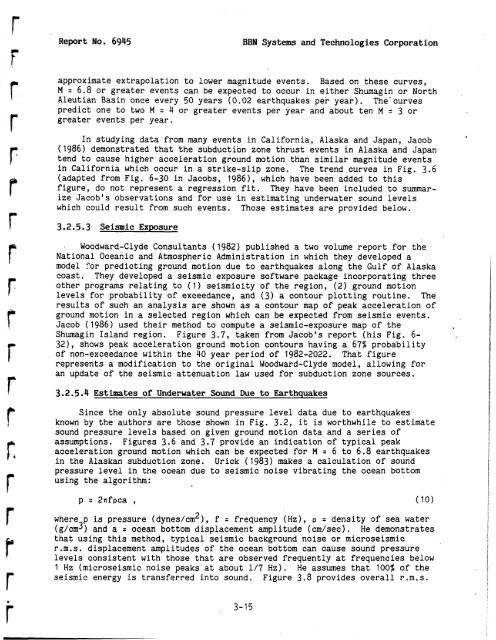Analysis and Ranking of the Acoustic Disturbance Potential of ...
Analysis and Ranking of the Acoustic Disturbance Potential of ...
Analysis and Ranking of the Acoustic Disturbance Potential of ...
You also want an ePaper? Increase the reach of your titles
YUMPU automatically turns print PDFs into web optimized ePapers that Google loves.
Report No. 6945<br />
BBN Systems <strong>and</strong> Technologies Corporation<br />
approximate extrapolation to lower magnitude events. Based on <strong>the</strong>se curves,<br />
M = 6.8 or greater events can be expected to occur in ei<strong>the</strong>r Shumagin or North<br />
Aleutian Basin once every 50 years (0.02 earthquakes per year). The-curves<br />
predict one to two M = 4 or greater events per year <strong>and</strong> about ten M = 3 or<br />
greater events per year.<br />
In studying data from many events in.California, Alaska <strong>and</strong> Japan, Jacob<br />
(1986) demonstrated that <strong>the</strong> subduction zone thrust events in Alaska <strong>and</strong> Japan<br />
tend to cause higher acceleration ground motion than similar magnitude events<br />
in California which occur in a strike-slip zone. The trend curves in Fig. 3.6<br />
(adapted from Fig. 6-30 in Jacobs, 1986), which have been added to this<br />
figure, do not represent a regression fit. They have been included to summarize<br />
Jacob's observations <strong>and</strong> for use in estimating underwater sound levels<br />
which could result from such events. Those estimates are provided below.<br />
3.2.5.3 Seismic Exposure<br />
. Woodward-Clyde Consultants (1982) published a two volume report for <strong>the</strong><br />
National Oceanic <strong>and</strong> Atmospheric Administration in which <strong>the</strong>y developed a<br />
model for predicting ground motion due to earthquakes along <strong>the</strong> Gulf <strong>of</strong> Alaska<br />
coast. They developed a seismic exposure s<strong>of</strong>tware package incorporating three<br />
o<strong>the</strong>r programs relating to (1) seismicity .<strong>of</strong> <strong>the</strong> region, (2) ground motion<br />
levels for probability <strong>of</strong> exceedance, <strong>and</strong> (3) a contour plotting routine. The<br />
results <strong>of</strong> such an analysis are shown as a contour map <strong>of</strong> peak acceleration <strong>of</strong><br />
ground motion in a selected region which can be expected from seismic events.<br />
Jacob (1986) used <strong>the</strong>ir method to compute a seismic-exposure map <strong>of</strong> <strong>the</strong><br />
Shumagin Isl<strong>and</strong> region. Figure 3.7, taken from Jacob's report (his Fig. 6-<br />
32), shows peak acceleration ground motion contours having a 67% probability<br />
<strong>of</strong> non-exceedance within <strong>the</strong> 40 year period <strong>of</strong> 1982-2022. That figure<br />
represents a modification to <strong>the</strong> original Woodward-Clyde model, allowing for<br />
an update <strong>of</strong> <strong>the</strong> seismic attenuation law used for subduction zone sources.<br />
3.2.5.4 Estimates <strong>of</strong> Underwater Sound Due to Earthquakes<br />
Since <strong>the</strong> only absolute sound pressure level data due to earthquakes<br />
known by <strong>the</strong> authors are those shown in Fig. 3.2, it is worthwhile to estimate<br />
sound pressure levels based on given ground motion data <strong>and</strong> a series <strong>of</strong><br />
assumptions. Figures 3.6 <strong>and</strong> 3.7 provide an indication <strong>of</strong> typical peak<br />
acceleration ground motion which can be expected for M = 6 to 6.8 earthquakes<br />
in <strong>the</strong> Alaskan subduction zone. Urick (1983) makes a calculation <strong>of</strong> sound<br />
pressure level in <strong>the</strong> ocean due to seismic noise vibrating <strong>the</strong> ocean bottom<br />
using <strong>the</strong> algorithm:<br />
where p is pressure (dynes/cm2), f = frequency (Hz), p = density <strong>of</strong> sea water<br />
(g/cm3) <strong>and</strong> a = ocean bottom displacement amplitude (cm/sec) . He demonstrates<br />
that using this method, typical seismic background noise or microseismic<br />
r.m.s. displacement amplitudes <strong>of</strong> <strong>the</strong> ocean bottom can cause sound pressure<br />
levels consistent with those that are observed frequently at frequencies below<br />
1 Hz (microseismic noise peaks at about 1/7 Hz). He assumes that 100% <strong>of</strong> <strong>the</strong><br />
seismic energy is transferred into sound. Figure 3.8 provides overall r.m.s.
















